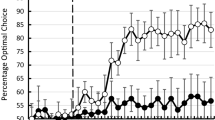Abstract
Pigeons were trained in two experiments that used the concurrent-chains proce-dure. These experiments sought to identify the variables controlling the prefer-ence of pigeons for a constant duration over a variable duration of exposure to an aperiodic, time-based, terminal-link schedule. The results indicated that two variables correlated with the constant-duration terminal link combined to con-trol preference: (a) a shorter initial delay to a rein forcer; and (b) the probabilistic occurrence of multiple rein forcers.
Similar content being viewed by others
References
AUTOR, S. M. (1960). The strength of conditioned reinforcers as a function of frequency and probability of reinforcement. Unpublished doctoral dissertation, Harvard University.
AUTOR, S. M. (1969). the strength of conditioned reinforcers as a function of frequency and probability of reinforcement. In D. P. Hendry (Ed.), Conditioned reinforcement (pp. 127–162). Homewood, Il: Dorsey Press.
FLESHLER, M., & HOFFMAN, H. (1962). A progression for generating variable-interval schedules. Journal of the Experimental Analysis of Behavior, 5, 529–530.
GENTRY, G. D., & MARR, M. J. (1980). Choice and reinforcement delay. Journal of the Experimental Analysis of Behavior, 33, 27–37.
GRACE, R., & NEVIN, J. A. (2000). Comparing preference and resistance to change in constant-and variable-duration schedule components. Journal of the Experimental Analysis of Behavior, 74, 165–188.
FANTINO, E., & HERRNSTEIN, R. J. (1968). Secondary reinforcement and number of primary reinforcements. Journal of the Experimental Analysis of Behavior, 11, 9–14.
HERRNSTEIN, R. J. (1964). Aperiodicity as a factor in choice. Journal of the Experimental Analysis of Behavior, 7, 179–182.
KILEEN, P. (1968). On the measurement of reinforcement frequency in the study of preference. Journal of the Experimental Analysis of Behavior, 11, 263–269.
MAZUR, J. E. (1984). Tests of an equivalence rule for fixed and variable reinforcer delays. Journal of Experimental Psychology: Animal Behavior Processes, 10, 426–436.
MAZUR, J. E. (1986). Choice between single and multiple delayed reinforcers. Journal of the Experimental Analysis of Behavior, 46, 67–77.
MAZUR, J. E. (1987). An adjusting procedure for studying delayed reinforcement. In M. L. Commons, J. E. Mazur, J. A. Nevin, & H. Rachlin (Eds.), Quantitative analyses of behavior: Vol. 5. The effect of delay and intervening events on reinforcement value (pp. 55–73). Hillsdale, NJ: Erlbaum Associates.
MAZUR, J. E. (2001). Hyperbolic value addition and general models of animal choice. Psychological Review, 108, 96–112.
MAZUR, J. E. (2006). Choice between single and multiple reinforcers in concurrent-chains schedules. Journal of the Experimental Analysis of Behavior, 86, 211–222.
MCDIARMID, C. G., & RILLING, M. E. (1965). Reinforcement delay and reinforcement rate as determinants of schedule preference. Psychonomic Science, 2, 195–196.
MILLENSON, J. R. (1963). Random interval schedules of reinforcement. Journal of the Experimental Analysis of Behavior, 5, 437–443.
MOORE, J. (1979). Choice and number of reinforcers. Journal of the Experimental Analysis of Behavior, 32, 51–63.
MOORE, J. (1984). Choice and transformed interreinforcement intervals. Journal of the Experimental Analysis of Behavior, 42, 32l–335.
PONIEWAZ, W. R. (1984). Effects on preference of reinforcement delay, number of reinforcers, and terminal-link duration. Journal of the Experimental Analysis of Behavior, 42, 255–266.
SHULL, R. L., MELLON, R. C., & SHARP, J. A. (1990). Delay and number of food reinforcers: Effects on choice and latencies. Journal of the Experimental Analysis of Behavior, 53, 235–246.
SHULL, R. L., SPEAR, D. J., & BRYSON, A. E. (1981). Delay or rate of food delivery as a determiner of response rate. Journal of the Experimental Analysis of Behavior, 35, 129–143.
SNYDERMAN, M. (1983). Delay and amount of reward in a concurrent chain. Journal of the Experimental Analysis of Behavior, 39, 437–447.
STUBBS, D. A., & PLISKOFF, S. S. (1969). Concurrent responding with fixed relative rate of reinforcement. Journal of the Experimental Analysis of Behavior, 12, 88789.
Author information
Authors and Affiliations
Corresponding author
Rights and permissions
About this article
Cite this article
Moore, J. Choice and the Initial Delay to a Reinforcer. Psychol Rec 58, 191–214 (2008). https://doi.org/10.1007/BF03395611
Published:
Issue Date:
DOI: https://doi.org/10.1007/BF03395611




